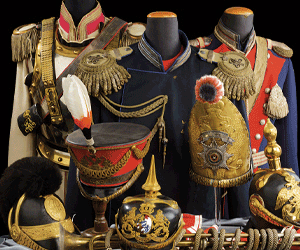Afrikakorps Waffen-SS Hauptscharführer Shoulder Boards
SKU: 23.GOR.03.02.02.04.002
Estimated market value:

Estimated market value:
Attributes
History
During the Second World War, German troops stationed in northern Africa are generally referred to as the Afrikakorps. Technically, this is not entirely correct, since some German units operating in Africa were not actually part of the DAK (Deutsches Afrikakorps), and some units of it were, in fact, Italian ones. However, for the purpose of collecting so-called “tropical” uniforms and insignia, collectors have simplified the meaning of the term.
The first German troops were sent to northern Africa in February of 1941, to support their Italian allies against the British. The climate of the African continent made it necessary to wear specialised uniforms and gear that not only supported the soldiers in serving in a hot and arid environment, but also helped them in blending in with the landscape, which, in general, presented itself as brown, olive, khaki, or sand/tan in colour. Worn over long periods of time under the blistering desert sun, some uniforms were eventually bleached to white or off-white. Uniforms and insignia in these colours are often referred to as “tropical”, and it is worth noting that they weren’t just worn by members of units stationed in Africa, but in the entire Mediterranean theatre of war, including southern France, Italy, the Balkans, and Greece, as well as in southern Russia during the summer months. Tropical uniforms were worn by members of all three branches of the Wehrmacht: the Heer (army), the Kriegsmarine (navy), and the Luftwaffe (air force). Members of the Waffen-SS stationed in southerly regions also wore tropical-style uniforms, and even though they technically have no connection to the DAK, all tropical uniforms and insignia of all branches of the German military are listed here.
Waffen-SS shoulder boards were introduced in 1935 for NCO/EMs and in 1938 for Officers. They indicated the rank and service branch of the wearer. They closely follow the design of Wehrmacht shoulder boards, but with slight differences.
The shoulder boards of all Officer grades, excluding General Officers, started with a black base upon which a secondary layer in the appropriate service branch colour (Waffenfarbe) was attached. A bullion braid or cord was then fastened to the top.
NCO/EM’s (Non-Commissioned Officers/Enlisted Men) shoulder boards were made with a wool base, which always had a black upper side. Some shoulder boards have a grey wool underside, while others have a black underside. The outer piping of the shoulder boards denoted service branch, while tresses and metal pips denoted rank.
In the pre-war period, NCO tresses were manufactured out of silver coloured thread. Later shoulder boards were produced using white cotton thread, and the final design was manufactured using grey thread. Tress on Tropical style shoulder boards was in copper or brown colour.
Enlisted Men that were deemed NCO candidates wore a single stripe of tress at the bottom of their shoulder straps if they had committed to 12 years of service, while those that hadn’t wore a single strand of twist cord, either silver-coloured or in the wearer’s Waffenfarbe.
Similarly, NCOs who were Officer candidates wore two stripes of tress at the bottom of their shoulder straps.
NCOs wore white metal rank pips.
A variety of unit numbers and other cyphers could be added to shoulder boards to indicate membership in an elite formation or specialist unit. They could also indicate the assignment or training school of the wearer.
Officer grades received metal cyphers in gilt, while NCOs received silvered metal cyphers. EMs wore removable cloth loops with an embroidered cypher or had the cyphers directly embroidered onto their shoulder straps.
Pre-1940 cyphers featured Gothic script, while starting in 1940 this was changed to Latin script.
Career insignia includes, but are not limited to:
Medical: Rod of Asclepius
Veterinary: Snake
Technical Services: Wheel Cog
Flak: Fl
Panzerjäger: P
Training/School insignia include, but are not limited to:
Music School: Lyre
Unterführerschule Radolfzell: US R
Unterführerschule Lauenburg: US L
Junkerschule Tölz: JS T
Junkerschule Braunschweig: JS B
Haupt Reiter-Schule: R SH
Regiment/Division insignia include, but are not limited to:
SS Leibstandarte Adolf Hitler: LAH
SS-Standarte “Deutschland”: D
SS-Standarte “Germania”: G
SS-Standarte “Der Führer”: DF
Panzer-Lehr-Division: L
A simplified approximation of branch colours follows:
Silver or grey: Generals
White: Infantry
Red: Artillery
Black: Engineers (“Pioniere”)
Lemon yellow: Signals
Pink: Armoured/Anti-Tank
Copper brown: Reconnaissance (1940-1942)
Golden yellow: Cavalry/Reconnaissance (1942-1945)
Dark blue: Medical
Grass green: Mountain Troops
Light blue: Supply Troops
Orange: Field Police/Special & Technical Services
Dark Green: Reserve & Special Services Officers (1940-1942)
Red & Grey: Special Services Officers (1942-1945)
Carmine: Veterinary
Wine red: Judicial
Light brown: Concentration Camp Personnel
Light pink: Transport Troops
Light salmon pink: Military Geologists
Sky blue: Administration
Only the more common branches among the above mentioned ones were included in certain MedalBook chapters. The rarer items of uncommon branches may be added in the future if images become available.
The rank of SS-Hauptscharführer was first incorporated into the SS rank structure in 1934.
The rank was typically bestowed on Waffen-SS members who were company and battalion Non-Commissioned Officers. Individuals holding this rank were often granted the title of Stabsscharführer, which was an appointment held by the senior NCOS of a company, battalion, or regiment.
The SS-Hauptscharführer shoulder boards feature tresses and two metal pips.


Comments
Sign in to comment and reply.


Scroll Top